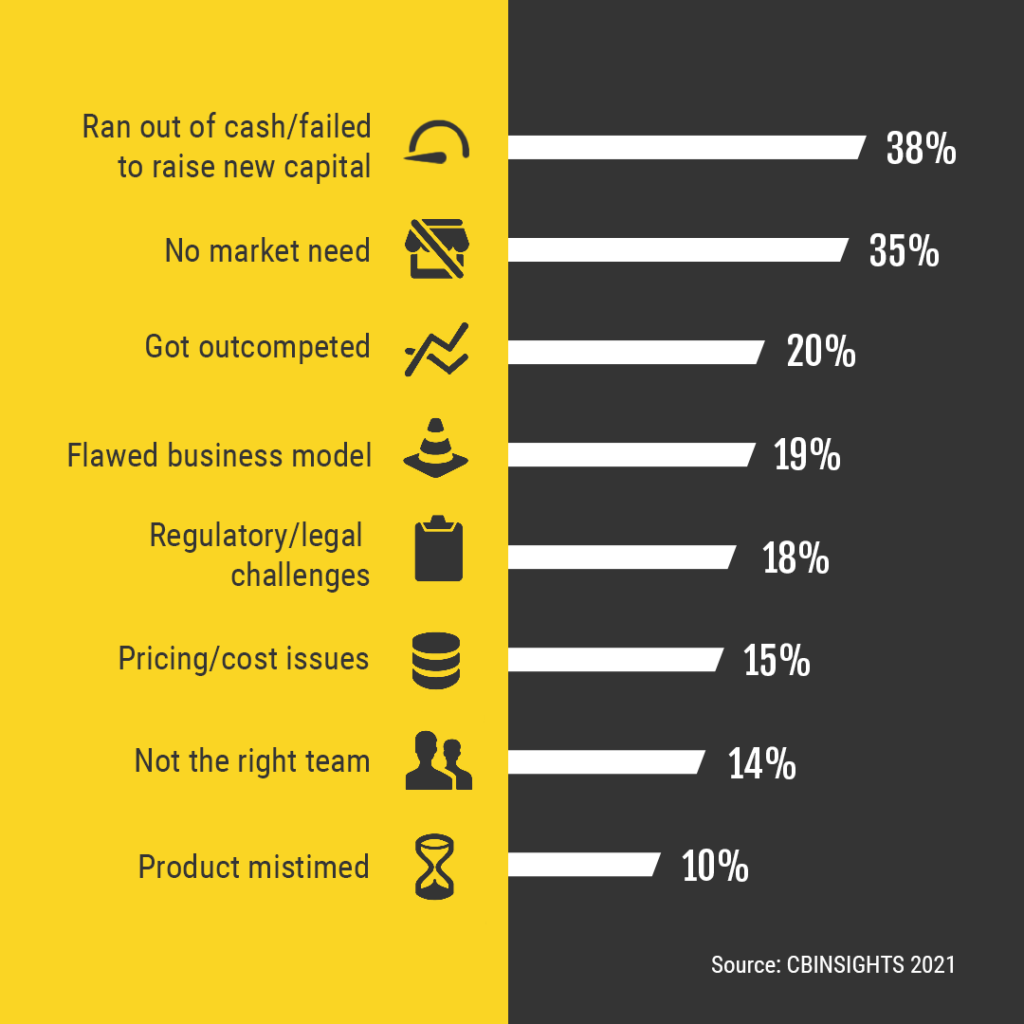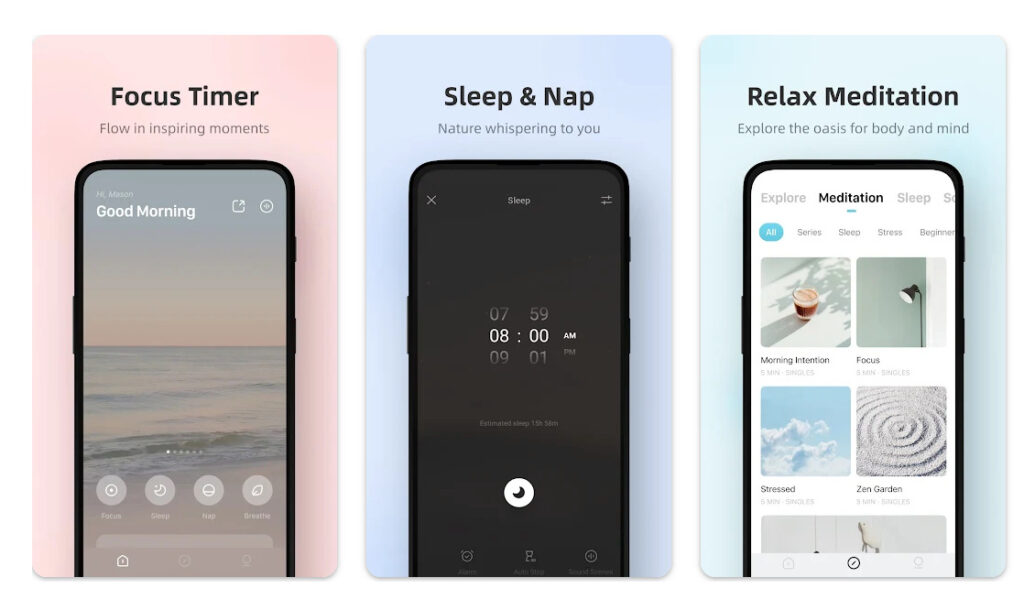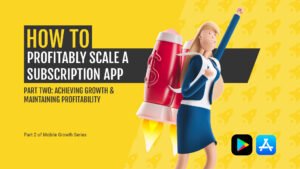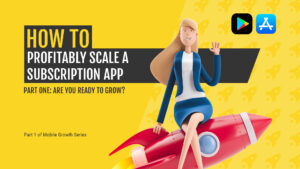This is the first part of the Mobile Growth Series, which aims to help you take your app to the next level. In each episode, we will provide insights into topics related to data, product optimization, and growth strategy. Subscribe to our newsletter to stay updated about future episodes.
What you will learn in this article:
- Which Growth Phase your startup must reach to begin scaling
- The importance of having a strong Unique Selling Point (USP) in order to scale
- Three ways to position your mobile app on the market
Profitably scale. Sounds good right? In reality, it’s pretty damn difficult to do. First of all, you need to understand if your subscription-based app meets the conditions to eventually do it. Don’t get me wrong… you can still have a decent small or medium business, but “scaling” is an entirely different beast.
The aim of this article is to improve your chance to get there. Let’s begin by covering the word “scale“.
Part One: Are you ready to scale?
There are two important things that you should know about scaling. The first is that you start to scale only at a specific stage of the company’s growth. Are you there already?
The second is that you need a solid foundation in terms of USP (Unique Selling Proposition) and Product Positioning. Really? Yes, underestimating these two elements in the early stages is a business killer.
According to the CB Insights Report 2021, the second most common reason for startups to fail is that they created a product or service that nobody wants. In the majority of cases, startups fail because they don’t have a strong USP (low value offered – low perceived benefit by the user – not solving a real problem) and they were not able to appeal to a relevant share of the market.
Here is where Product Positioning is the key to success. And don’t worry, we’ve got you covered with a simple framework that you can use to adjust your subscription app strategy.
During what growth phase does a startup begin to scale?
Based on a very simple but powerful visualization created by Brian Balfour (former VP of Growth at HubSpot), every startup goes through three phases of growth: Traction, Transition, and Growth.
Take a look at the table below to assess where your company falls:
This is important because a company only starts “scaling” when it moves away from the Transition phase and enters the Growth phase. Only a few businesses reach this point–consider a company that normally has 20-50 employees and hit a $1-10 million annual revenue milestone. The majority of startups actually remain and die in the initial stage (Traction).
So how can you prevent this from happening to your business?
Finding a product-market fit is the holy grail that could provide your business with prosperity. This is achievable only if the market responds well to your product/service and you can compete with other players.
The Importance of a USP for app scaling
In the mobile business, the huge number of apps available on each Store (Google Play Store and App Store) makes the competition incredibly fierce. How can you possibly stand out from the crowd?
Let’s assume that you want to download a meditation app to relieve stress and sleep better. There are tons of options, but the user will most likely subscribe to only one of them.
A large part of the solution is to have a strong USP to match the user’s motivation. Let’s break this down:
- Unique: different from competitors; relevant; the logical choice for users
- Selling: strong enough to persuade people to pay for it
- Proposition: related to the benefit that you provide or the problem you solve
Let’s take a look at an example of three different apps that caught my attention after searching for the term “meditation app” in the Google Play Store.
App #1 - Insight Timer: Meditation App
This app’s USP is the fact that it can provide access to “the largest library of free well-being content on Earth“. Backed by more than 5 million downloads, 206k reviews, and a 4.8-star rating, it’s a strong candidate to capture our attention.
For this particular use case, though, it may appear overwhelming to someone who is just beginning their journey with mediation.
App #2 - Tide: Sleep & Meditation
Can this app stand a chance at grabbing our attention by focusing more on its features (e.g. Focus Timer)?
It currently has more than 1 million downloads and a 4.6-star rating. In the screenshots, however, we’re not seeing a clear reason why this app is different from competitors, nor are we seeing how it’s supposed to solve users’ real problems. At least the app title matches what we’re looking for.
App #3 - Breethe: Meditation & Sleep.
Unlike the other two we’ve looked at, this app really appears to connect with my problem and provide a solution via mediation. It also offers a clear benefit: “Get the best sleep of your life.“
I absolutely want that.
It has a 4.7-star rating and 500k downloads (according to Google data). As a smaller brand, they are supporting their USP and providing credibility with social proof and the success of being featured in famous publications.
So, which app is the winner?
If you were to download just one of these three apps, which one would you choose? Well, the decision process is definitely influenced by the initial motivation of the user, the store asset choices, and the information provided by the store itself.
But assuming that the main reason to download was to try out meditation as a solution for better sleep, Breethe seems like it could really win over the more well-known players.
Ultimately, USP wins!
What is clear from these examples is that the USP is critical, but your subscription app is not alone out there. Every day you are competing to win the selection process inside the mind of the user. This process is incredibly quick, and to simplify this for the user in your favor, you can use Product Positioning Techniques.
How to approach Product Positioning in order to isolate, target, and win a market
April Dunford, author of the book Obviously Awesome: How to Nail Product Positioning so Customers Get It, Buy It, Love It, provides this definition: “Positioning is the act of deliberately defining how you are the best at something that a defined market care a lot about.”
In the same book (that I highly recommend reading), there is a very useful three-step framework that can be used to understand how to approach positioning correctly.
Three Ways to Position Your Mobile App on the Market

Head to HEad
As the title of this approach suggests, you are going to be “directly” competing with the top of your category. It’s the most difficult to execute and normally requires a lot of resources if you want to buy your way in and eat a relevant share of the market.
Here’s what you need the consider in this case:
- The users already know what to expect (the other players are acting as a benchmark, and the basic/top features of these apps are quite well-defined). Can your app pass the bar?
- Keep in mind that you don’t have to convince people about the category itself. It already exists, especially in the mind of the users.
- This approach is rarely suitable for new apps.
- Consider this only if you have a strong USP (AKA why your app is better than the most famous ones) as well as money to invest.
Example: You have a meditation app and want to go after big names like Calm or Headspace. If you are at the top of the category, you must always remark that you are the leader, stay at the top of your mind, keep innovating, and continue to reclaim the first spot. If you are a new app on the market, however, you need to compete with the same rules and have a strong USP.
The Ten Percent Happier app, which is relatively new, managed to find its spot in the meditation space. This was due to the success of a homonymous book and podcast focusing on the quality of the courses, as well as the more fun and realistic tones of voice that it connected to mediation.
They found Golias’s weak point, and thanks to the gained media exposure and their own book and podcast, they managed to create a brand strong enough to compete with high-level players.
Big Fish, Small pond
In this approach, you move sideways to avoid the frontal clash with top players. You can create a relevant spot for yourself (big fish) in just a portion of the market (small pond).
Here’s what to consider in this case:
- You should focus on the unsatisfied and important needs of the users.
- The hyper-specialization already provides you with a good starting point to build your USP.
- It could act as a starting point only for you to expand later.
- The market needs to be big enough (at least in the short term).
Example: You have a weight-loss app. How do you compete with huge apps like MyFitnessPal: Calorie Counter or WW / WeightWatchers?
One possible answer is to create an app that’s much more specialized and severs one relevant niche of users, such as a workout app for women. This is already the positioning of apps like FitHer: Workout for Women or Workout for Women: Fit at Home.
Some developers also found it interesting to be even more specialized by creating apps that offer yoga as a weight loss solution for women.
Create a New Game
When the service that you are providing is totally new, there are no competitors to take into consideration. You are the pioneer.
Here’s what to consider in this case:
- It’s a difficult style of positioning (to be chosen by exclusion).
- You need to first create demand or retain high visibility to make it work.
- It’s often connected to new emerging technologies.
Example: Nowadays, AI is offering many opportunities. The Replika: My AI Friend app practically invented the category of “chatbot companions” that is powered by artificial intelligence.
In the beginning, nobody was looking for this kind of service or keywords, so the company had to power up the PR to get some brand recognition and encourage people to give it a try.
USP and Positioning vs full-funnel performance
How can USP and Positioning positively impact full-funnel performance?
- Ads will be more relevant. As a result, you will have a lower CPM and a better CTR.
- Messaging on the Store will be more compelling and easier to understand for the target audience. A higher conversion rate can be expected and will lead to a lower CPI.
- Solving the real problems of users and providing tangible benefits will lead to an app with a higher retention rate.
- More people in the funnel and with high intent means better monetization (lower CAC and higher LTV).
- A higher chance to reach Product-Market Fit.
Our Recommendation
We encourage you to give the right consideration to USP and Positioning. Start with a USP in mind to build your product and marketing strategy. Remember that you are not alone and need to carefully position your product/service to succeed and unlock growth at scale.
Continue Reading
You can’t grow without a good cost/revenue structure. For early-stage apps, you need to show numbers that are good enough to convince investors and lead your business to the next investment round.
In Part Two of this article, we will discuss strategies for achieving growth while maintaining profitability. 💰
For more information on the topic, check out this webinar featuring Independent Growth Consultant Thomas Petit and author of this article Roberto Sbrolla:
Keep up with appagent
📕 Learn more about industry insights and best practices by signing up for our newsletter.
🤝 Get help with growth strategy, app marketing, user acquisition and video ad production by contacting us at hi@appagent.com.
👉 Follow us on LinkedIn, Twitter, YouTube, Slideshare, Facebook, and Instagram.
👥 Join our team as an Idea Maker, Creative Director, or Art Director.
RELATED ARTICLES




















